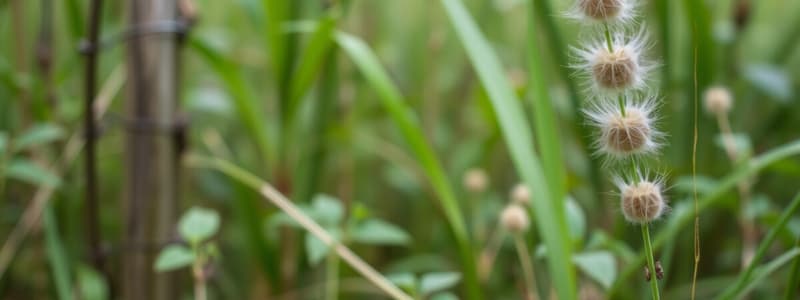Podcast
Questions and Answers
What term describes a group of individuals that share similar characteristics and can exchange genetic material for reproduction?
What term describes a group of individuals that share similar characteristics and can exchange genetic material for reproduction?
- Species (correct)
- Community
- Ecosystem
- Population
Which distribution pattern describes organisms that are spread in a fairly regular pattern throughout their habitat?
Which distribution pattern describes organisms that are spread in a fairly regular pattern throughout their habitat?
- Clumping distribution
- Uniform distribution (correct)
- Random distribution
- Even distribution
What is the term for the maximum number of living organisms a habitat can sustain without causing damage?
What is the term for the maximum number of living organisms a habitat can sustain without causing damage?
- Sustainability point
- Population limit
- Resource threshold
- Carrying capacity (correct)
Which process describes the rise in the Earth's average temperature due to factors such as greenhouse gas emissions?
Which process describes the rise in the Earth's average temperature due to factors such as greenhouse gas emissions?
What is Biological Magnification?
What is Biological Magnification?
Which phenomenon occurs when air pollutants cause chemical reactions that create acidic compounds in the environment?
Which phenomenon occurs when air pollutants cause chemical reactions that create acidic compounds in the environment?
What term refers to the destruction and conversion of forest land for purposes such as agriculture or mining?
What term refers to the destruction and conversion of forest land for purposes such as agriculture or mining?
Mass extinctions are characterized by:
Mass extinctions are characterized by:
What is the primary driving force behind the process of evolution?
What is the primary driving force behind the process of evolution?
Which process best describes the adjustment of an organism's genetic traits in response to environmental challenges?
Which process best describes the adjustment of an organism's genetic traits in response to environmental challenges?
What does extinction indicate regarding a species?
What does extinction indicate regarding a species?
In the context of evolutionary theory, what is a crucial factor for organisms to successfully reproduce?
In the context of evolutionary theory, what is a crucial factor for organisms to successfully reproduce?
How does genetic mutation contribute to the process of adaptation?
How does genetic mutation contribute to the process of adaptation?
Flashcards are hidden until you start studying
Study Notes
Ecosystem and Biodiversity
- An ecosystem is a geographic area where organisms, climate, and topography interact, creating a life system.
- Biodiversity refers to the variety of living organisms on Earth, encompassing all biological organization levels.
Species and Population
- A species is a group of individuals sharing similar characteristics capable of genetic exchange for reproduction.
- A population consists of individuals of the same species interacting in a particular area.
Community Interactions
- A community is formed when different populations of species interact within an ecosystem.
Distribution Patterns
- Uniform distribution results in a regular pattern of species spread.
- Random distribution is observed when resources are unevenly distributed.
- Clumping distribution occurs when resources are patchy.
Population Dynamics
- Population density measures the number of individuals per unit area.
- Limiting factors are conditions that restrict population growth.
- Carrying capacity is the maximum number of organisms a habitat can sustainably support without damage.
Pollution Effects
- Air pollution includes harmful particulates or biological molecules in the atmosphere affecting humans, plants, and animals.
- Smog is a common consequence of air pollution.
- Air pollutants can have various detrimental effects on health and ecosystems.
- Global warming signifies the rise in the Earth's temperature.
- Acidification occurs when air pollutants form acidic compounds harmful to vegetation and buildings.
- Particulate matter is a concerning air pollutant with serious health impacts.
Water Pollution
- Water is normally tasteless, odorless, and colorless; pollution alters its chemical, physical, and biological properties.
- Biological magnification leads to increasing concentrations of toxic chemicals in water bodies.
- Eutrophication is defined as an increase in nutrient concentration in aquatic environments.
Forest and Land Use Changes
- Forest degradation refers to the destruction of specific forest aspects, including tree cover reduction and species loss.
- Deforestation is the conversion of forested land to other uses like agriculture, mining, or infrastructure development.
Extinction Events
- Mass extinctions rapidly eliminate large numbers of species, occurring in relatively short geological timescales.
- Background extinction represents the normal rate of species elimination over extended periods due to natural evolutionary processes.
Evolution and Adaptation
- Evolution is the process by which organisms pass advantageous traits to offspring, aiding survival in their environment.
- Adaptation involves genetic changes or mutations that facilitate an organism’s survival and reproduction in a new environment.
Evolution
- A natural process leading to the transmission of traits from organisms to their offspring.
- Traits that enhance survival in a particular environment are favored through this process.
Adaptation
- Refers to genetic changes or mutations that occur in organisms.
- Essential for survival and reproduction in altered or new environments.
- Can be a response to environmental pressures, such as climate change or availability of resources.
Extinction
- Defined as the death of the last individual within a species.
- Marks the end of a species' existence and contributes to biodiversity loss.
- Often results from various factors, including habitat destruction, climate change, and competition with other species.
Studying That Suits You
Use AI to generate personalized quizzes and flashcards to suit your learning preferences.




